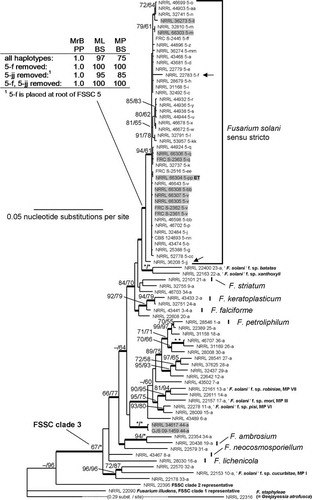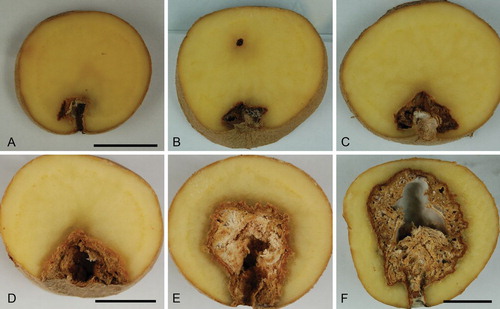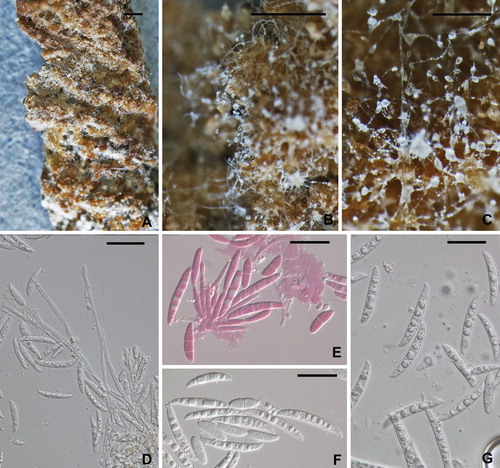Figures & data
Fig. 1 Reproduction of selected elements of the original drawings by Citationvon Martius (1842) illustrating Fusisporium solani, the causal agent of potato dry rot. Original figure numbers were kept. 26–28. Repeatedly branched conidiophores, comparable to sporodochial conidiophores illustrated in , bearing multi-septate, Fusarium-like macroconidia. 29. Fusarium-like macroconidium with three pairs of lateral constrictions indicating the location of 3 putative septa. 30. Sparsely branched conidiophore with a still attached Fusarium-like macroconidium.

Fig. 2 Majority rule consensus phylogram from MrBayes analyses of the F. solani species complex (FSSC) inferred from rDNA (104/986 parsimony informative positions), TEF1 (117/709) and RPB2 (303/1738) sequences. Alphanumeric designations next to strain numbers indicate the three-locus haplotypes and species as described in CitationO’Donnell et al. (2008). The phylogenetic species FSSC 5 is inferred as F. solani sensu stricto. Arrows indicate divergent haplotypes 5-f and 5-jj and boldface ‘ET’ the ex-epitype isolate NRRL 66304 (= FRC S-2364, CBS 140079, G.J.S. 09-1466). Values shown at nodes indicate ML and MP bootstrap support > 60%; asterisks above branches represent node support of 100% BS. Bold branches refer to nodes with a PP value of 0.95–1.00. Gray highlight is used to identify isolates from potato. The novel phylogenetic species FSSC 44 isolated from potato in Slovenia is represented by NRRL 34617 and G.J.S. 09-1459.

Fig. 3 A–F. Dry rot symptoms of potato tubers artificially infected with Fusarium solani. Tubers in A and B infected with strain NRRL 66303 (FRC S-2561, CBS 140075, G.J.S. 09-1464); C, D, E with ex-epitype strain NRRL 66304 (FRC S-2364, CBS 140079, G.J.S. 09-1466); F with FRC S-2368 (G.J.S. 09-1471). Scale bars: A, D, F = 2 cm. A applies for B, C; D applies for E.

Fig. 4 Fusarium solani from potato collected in the field. A–C. Macroscopic view of mycelium, conidiophores and conidia. Note the long conidiophores and slimy heads of conidia in B and C. D–G. Conidiophores and conidia. E stained in 1% (aq.) phloxine. All from NRRL 66304. Scale bars: A = 1 mm, B = 0.5 mm, C = 100 μm, D–G = 20 μm.

Fig. 5 Fusarium solani on carnation leaf agar. A. White to cream colored, slimy conidial masses formed by pionnote sporodochia on pieces of carnation leaf. B, C. Unbranched or sparsely branched conidiophores arising from the surface of the agar. D, E. 0-to-3 septate conidia produced from unbranched or sparsely branched conidiophores. F. Conidiophores from pionnote sporodochium producing up to 5-septate conidia. G–K. Conidia arising from pionnotes. L. Chlamydospores. A, C, E, J from FRC S-2362 (G.J.S. 09-1462); B, D, K, L from FRC S-2361 (G.J.S. 09-1461); F from NRRL 66307 (FRC S-2367, CBS 140077, G.J.S. 09-1469); G from FRC S-2363 (G.J.S. 09-1463); H, I from ex-epitype strain NRRL 66304 (FRC S-2364, CBS 140079, G.J.S. 09-1466). Scale bars: A = 1 mm; B–E, I, K = 20 μm; F–H, J = 30 μm; L = 10 μm.


